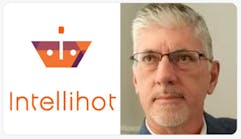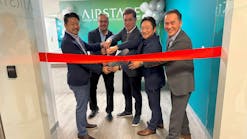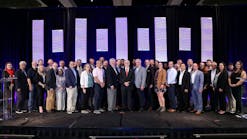Fan Selections
This (“Fan Selections and Their Energy Impacts, Part 1 of 2,” September 2016) may be the most well-written and useful technical article I’ve ever read in a magazine. The example problems and figures were outstanding. I look forward to Part 2.
Randolph Bowers, REM, LEED AP, ENV SP
Civil and Environmental Technologies LLC
Wexford, Pa.
‘Lunching and Learning’
I was intrigued by Jeffrey Newcomb’s July 2016 article, “Lunching and Learning: Food for Thought on a Geothermal-Heat-Pump-System Design.” Almost 20 years ago, I tried to patent a system that had similar objectives, although it was quite different in design. It entailed individual circulators and a waterside reversing valve at each heat pump so that there was a “hot” header and a “cold” header. Regardless of the number of heat pumps running in each mode, each heat pump would be getting the most favorable temperature for its mode. Flow to the ground loop also was proportioned and reversed, all with simple control of the pump and valve at each heat pump. After much back-and-forth with the U.S. Patent Office, we gave up trying to answer their false claims about it being an “obvious extension of prior art.” On paper, it looked like a great idea.
However, after watching trends in the industry, I came to realize the added complexity and cost would not be offset by the gains in efficiency. Heat pumps are quite efficient now, and small changes in inlet temperature or entering fluid temperature produce only marginal gains in performance. The most cost-effective and energy-efficient systems normally are the simplest. A dear friend and colleague, the late Kirk Mescher, designed some of the best examples of systems with these traits, using just a single circulating pipe that each heat pump would take fluid from and then reject to, using a small pump with just a close coupling of supply and return to the one header pipe (see “One-Pipe Geothermal Design: Simplified GCHP System” by Kirk Mescher, ASHRAE Journal, October 2009). When Kirk and I first discussed this concept, it seemed so wrong to me from a second-law perspective, and I envisioned problems with the heat pumps further down the line on the single pipe. However, with today’s heat pumps and Kirk’s clever design, the systems perform better than most (see “Long-Term Commercial GSHP Performance, Part 4: Installation Costs” by Steve Kavanaugh, Mike Green, and Kirk Mescher, ASHRAE Journal, October 2012). Many concepts have been tried in the geothermal-heat-pump practice, and many of them have failed or became enormous consumers of energy and investment costs. Great guidance is available to designers of commercial-scale systems (see “Geothermal Heating and Cooling: Design of Ground-Source Heat Pump Systems” by Steve Kavanaugh and Kevin Rafferty, ASHRAE, 2014).
Also of note, systems that combine multiple building loads, as suggested by Newcomb’s article, have been built, again, pioneered by the late Kirk Mescher.
Gary Phetteplace, PhD, PE
GWA Research LLC
Lyme, N.H.
Author’s response:
The system with a hot-side/cold-side setup with all of the pumps at the individual heat pumps Mr. Phetteplace mentions has a lot of good points. I have considered that for other systems, too. As Mr. Phetteplace states, the reversing valves are just at the heat pumps, and no other pumps or valves are required to get the flow to get to, or reverse through, the ground loops. Another gem with this system is that the total pump power needed is very low when the system is at part load. Unneeded pumps are off, and circulation is reduced as load is reduced. At lower flows, the number of operating pumps is reduced, reducing the total pump power required. The problem for the system I was considering was tied to the need for many smaller heat pumps and, thus, small water pumps to go with them. Low-gpm pumps are not nearly as efficient as their larger brethren (approximately 30-percent efficiency vs. approximately 60-percent efficiency). Another problem was that the low-gpm pumps would not be able to operate with the required head at full load at a reasonable price. However, if larger heat pumps, such as chillers, could be used, that hot-side/cold-side idea would work very well.
Less pumping power is very important to a ground-loop-heat-pump system. In most systems, a design using more pump energy than required does not cause problems. For a chiller/cooling-tower system, extra heat from pumps might cause an overheating problem a few hours a year at most. However, the cumulative effect of over-pumping a geothermal system can cause temperature rise in the ground that can increase energy consumption and even cause a system to no longer work (see “Less Pumping Means Cooler Ground Loops” by Steve Kavanaugh, ASHRAE Journal, July 2011).
Having a better entering-water temperature (EWT) for water-source heat pumps provides greater efficiency, with the amount depending on the heat pump used. That is not a surprising result, as the amount of power a refrigerant compressor needs is related to “lift,” which is related to the compressor’s entering- and leaving-water temperatures. Better water temperatures reduce lift and required compressor power. For example, published data for ClimateMaster Tranquility 22 Model 30 shows that, at full cooling load, power consumption decreases about 17 percent as EWT drops from 90°F to 80°F. With the more efficient Tranquility 30 Model 26, power consumption decreases about 3 percent at full cooling load, but over 20 percent at part cooling load. Differences in efficiency can be quite large and vary between units.
I was lucky enough to attend a presentation concerning the geothermal system Kirk Mescher gave at the annual Illinois Geothermal Conference at Lake Land College in Mattoon, Ill., in March 2015. I was impressed by how he extended the capacity of the single-loop system by having multiple geothermal well systems connecting in at different points in the loop.
When it comes to heating and cooling, there is no perfect system that applies to all buildings. You have to look at the basics and initial conditions, space, equipment types, energy sources and sinks, and assumed maintenance capabilities. From there, you do the best you can with the budget available. That is part of what I like about engineering systems for buildings.
Jeffrey Newcomb, PE, MBA, LEED AP
IEFM Consulting Engineers
Coal Valley, Ill.
Letters on HPAC Engineering editorial content and issues affecting the HVACR industry are welcome. Please address them to Scott Arnold, executive editor, at [email protected].









